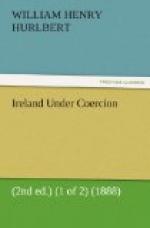VI.
We now come to close quarters.
Dr. Corrigan, as I have said, had become the Archbishop of New York in October 1885. The Irish-American Convention met at Chicago, Mr. Davitt dominating its proceedings by his courageous and outspoken support of his defeated Parliamentary allies in England. The candidacy of Mr. Henry George had not yet been announced in New York. But Dr. M’Glynn resumed his practice of addressing public meetings in support of the doctrines of Mr. Davitt and of Henry George. The Archbishop’s duty was plain. It was not pleasant. A Catholic prelate of Irish blood living in New York might have been pardoned for avoiding, if he could, an open intervention at such a moment, to prevent an able and popular priest from disobeying his ecclesiastical superiors in his zeal for a doctrine hostile to “landlordism,” and cordially approved by the most influential of the Irish leaders.
But on the 21st August 1886, while all the Irishmen in New York were wild with excitement over the proceedings at Chicago, Archbishop Corrigan did his duty, and admonished Dr. M’Glynn to restrain his political ardour. The admonition was thrown away. A month later, the canvass of Mr. Henry George being then fully opened, Dr. M’Glynn sent Mr. George himself to wait upon the Archbishop with a note of introduction as his “very dear and valued friend,” in the hope of inducing the Archbishop to withdraw his inhibition and allow him to speak at a great meeting, then about to be held, of the supporters of Mr. George.
The Archbishop replied in a firm but friendly note, forbidding Dr. M’Glynn “in the most positive manner” to attend the meeting referred to, or “any other political meeting whatever.”
Dr. M’Glynn deliberately disobeyed this order, attended the meeting, and threw himself with ever increasing heat into the war against landlordism. On the 2d of October 1886, therefore, he was formally “suspended” from his priestly functions—nor has he ever since been permitted to resume them. Another priest presides over the great church of St. Stephen, of which he was the rector. More than once the door of repentance and return has been opened to him; but, I believe, he is still waging war in his own way, and beyond the precincts of the priesthood, both upon the right of private property in land and upon the Pope.
He is a man of vigorous intellect; and he has defined the issue between himself and the Church in language so terse and clear that I reproduce it here. It defines also the real issue of to-day between the Church speaking through the Papal Decree of April 20, 1888, and the National League of Ireland acting through the “Plan of Campaign.”
No heed having been paid by Dr. M’Glynn to several successive intimations summoning him to go to Rome and explain his attitude, he finally, on the 20th of December 1886, wrote a letter in which, with a single skilful turn of his wrist, he took out the core of Henry George’s doctrine as to land, which really is the core also of the Irish Plan of Campaign, and thus laid it before the Archbishop of New York:—




